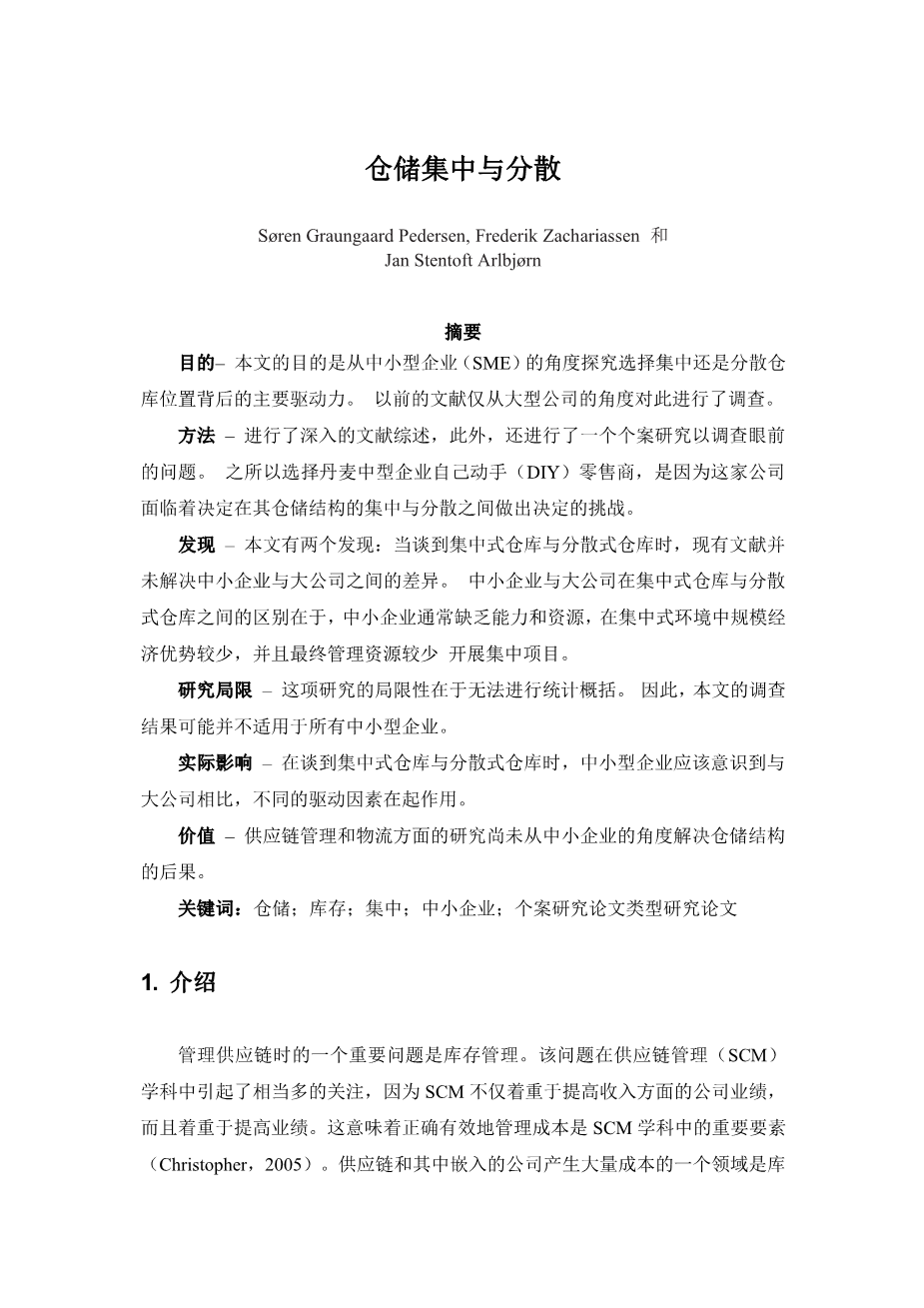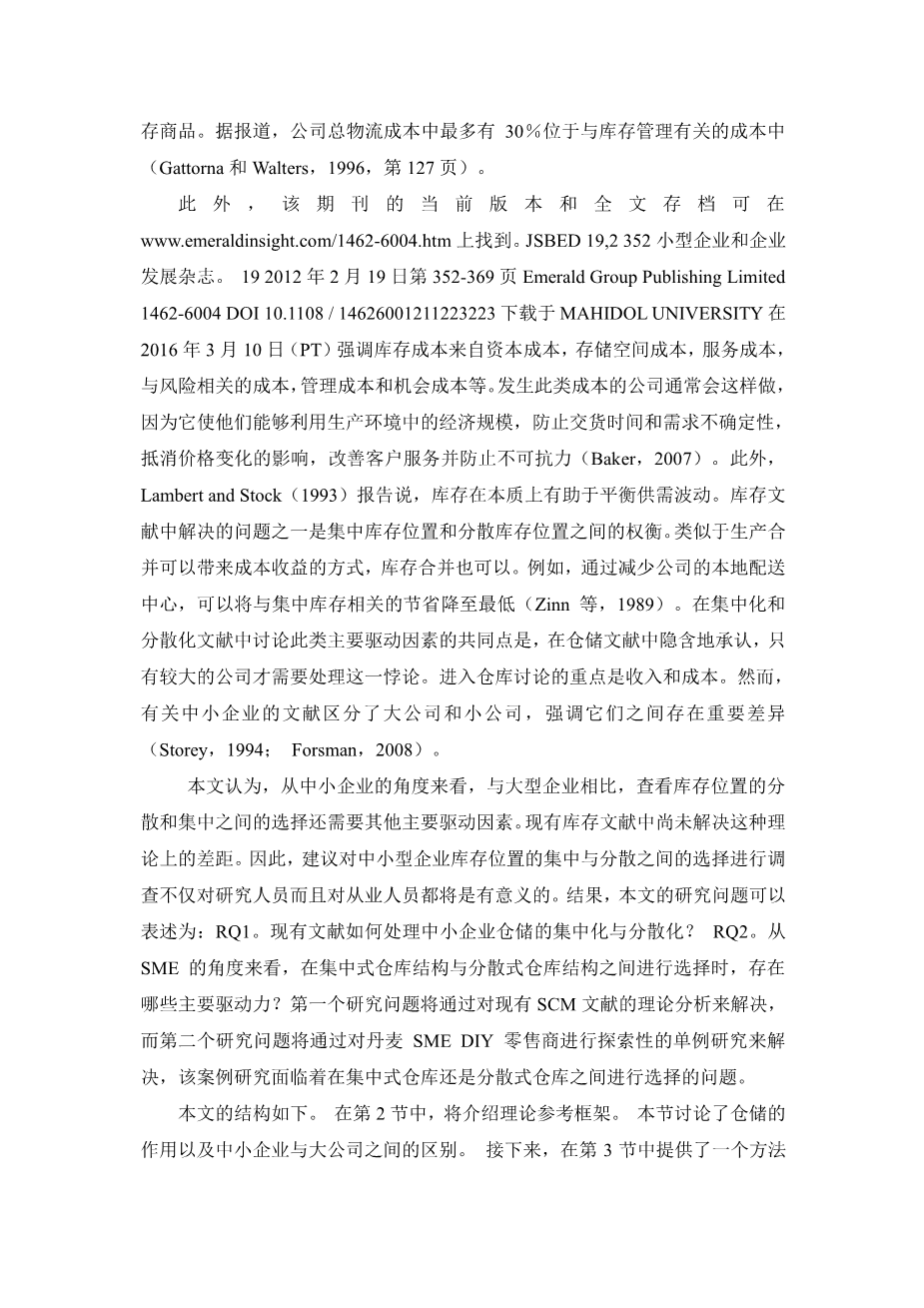Centralisation vs de-centralisation of warehousing A small and medium-sized enterprise perspective
Soslash;ren Graungaard Pedersen, Frederik Zachariassen and
Jan Stentoft Arlbjoslash;rn
Abstract
Purpose – The purpose of this paper is to explore the major drivers behind the choice of centralising versus decentralising warehousing locations from a small- and medium-sized enterprise (SME) perspective. Previous literature has investigated this solely from a large company perspective.
Design/methodology/approach – An in-depth literature review was carried out and, in addition, a single case study was conducted in order to investigate the issue at hand. A Danish medium-sized do-it-yourself (DIY) retailer was chosen, as this company faced the challenge of deciding between centralisation vs decentralisation of its warehousing structure.
Findings – The paper has two fifindings: existing literature does not deal with the difference between SMEs and large companies when speaking of centralised vs decentralised warehousing; and the difference between SMEs and large companies with regard to centralised vs decentralised warehousing lies in the fact that SMEs generally have scarcity in competences and fewer resources, have fewer advantages of economies of scale in a centralised setting, and, fifinally, have fewer management resources to carry out a centralisation project.
Research limitations/implications – It is a limitation of this research that a statistical generalisation is not possible. Therefore, the fifindings in this paper might not be applicable for all SMEs.
Practical implications – When speaking of centralising vs decentralising warehousing, SMEs should be aware that different drivers are at play when compared with larger companies.
Originality/value – Research in supply chain management and logistics has not addressed the consequences of warehousing structure from an SME perspective.
KeywordsWarehousing, Inventory, Centralization, Small to medium-sized enterprises, Single case study Paper type Research paper
1. Introduction
An important issue when managing supply chains is that of inventory management. This issue has received a fair amount of attention in the Supply Chain Management (SCM) discipline, as SCM focuses not only on improving the top-line of the company in terms of revenues, but also on improving the bottom-line. This implies that managing costs properly and effectively is a vital element in the SCM discipline (Christopher, 2005). One area in which supply chains and the companies embedded in these incur signifificant costs is in stocking goods in inventories. It has been reported that up to 30 per cent of a companyrsquo;s total logistics costs can be located in costs pertaining to inventory management (Gattorna and Walters, 1996, p. 127).
Furthermore, it has been The current issue and full text archive of this journal is available at www.emeraldinsight.com/1462-6004.htm JSBED 19,2 352 Journal of Small Business and Enterprise Development Vol. 19 No. 2, 2012 pp. 352-369 q Emerald Group Publishing Limited 1462-6004 DOI 10.1108/14626001211223946 Downloaded by MAHIDOL UNIVERSITY At 08:29 10 March 2016 (PT)stressed that inventory costs stem from capital costs, storage space costs, service costs, risk-related costs, administrative costs and opportunity costs, etc. Companies incurring such costs often do this because it enables them to take advantage of a scale of economies in production environments, protect against lead-time and demand uncertainty, counteract the effect of price changes, improve customer service and protect against force majeure (Baker, 2007). In addition, Lambert and Stock (1993) report that inventories essentially help in balancing out supply and demand flfluctuations. One of the problems addressed in inventory literature is the trade-off between centralising vs. decentralising inventory locations. Similar to the way that consolidation of production can deliver cost benefifits, so can the consolidation of inventory. Savings associated with centralising inventory can be obtained by reducing the companyrsquo;s local distribution centres, for example, thereby bringing these down to a minimum (Zinn et al., 1989). The common denominator for discussing such major drivers in centralisation vs. decentralisation literature is that it is implicitly acknowledged in the warehousing literature that only larger companies have to deal with this paradox. The warehousing discussion is approached with a focus on revenue and cost. The literature on small and medium-sized enterprises (SME), however, differentiates between smaller and larger companies, emphasising that important differences exist between them (Storey, 1994; Forsman, 2008).
In this paper, it is argued that viewing the choice between a decentralisation and centralisation of inventory locations entails other major drivers when seen from an SME perspective than when compared to a larger enterprise setting. This theoretical gap has not yet been addressed in existing inventory literature. As a result, it would not be unreasonable to suggest that an investigation of the choice between centralisation vs. decentralisation of inventory locations in SMEs would be interesting not only for researchers, but also for practitioners. As a result, the research questions of this paper can be formulated as: RQ1. How does the existing literature deal with centralisation vs. decentralisation of warehousing in SMEs? RQ2. Which major drivers exist with regard to the choice between centralised vs. decentralised warehousing structures when seen from an SME perspective? The fifirst research question will be addressed by a theoretical analysis of the existing SCM literature and the second research question will be addressed empirically throug
剩余内容已隐藏,支付完成后下载完整资料


英语译文共 7 页,剩余内容已隐藏,支付完成后下载完整资料
资料编号:[605462],资料为PDF文档或Word文档,PDF文档可免费转换为Word


